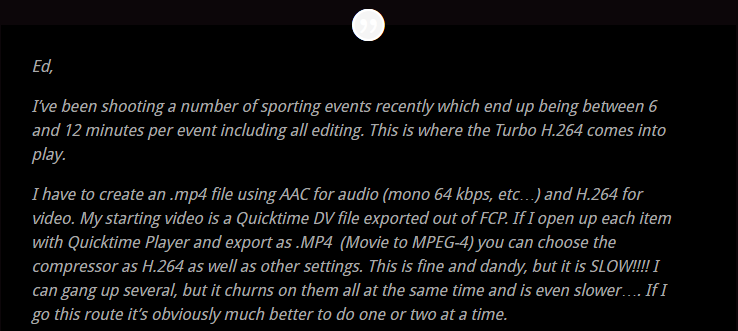I recently received this note from an editor, Mike, who was familiar with some of the web series we’ve done. More and more, TV and industrial post guys are being asked to deliver for the internet. My answers sum up some of the techniques I’ve learned in the last few years, so I thought I would share the conversation.
I use Elgato’s Turbo H.264 for some of my compression work. It’s fabulous. I know a lot of Pro’s that carry one in their pocket wherever they go (you know; in case someone has a video compression emergency — or something…).
Anyway, if you have ever been in Mike’s situation, I’d love to hear what your tips and trick might be. First, Mikes questions:
Ed,
I’ve been shooting a number of sporting events recently which end up being between 6 and 12 minutes per event including all editing. This is where the Turbo H.264 comes into play.
I have to create an .mp4 file using AAC for audio (mono 64 kbps, etc…) and H.264 for video. My starting video is a Quicktime DV file exported out of FCP. If I open up each item with Quicktime Player and export as .MP4 (Movie to MPEG-4) you can choose the compressor as H.264 as well as other settings. This is fine and dandy, but it is SLOW!!!! I can gang up several, but it churns on them all at the same time and is even slower…. If I go this route it’s obviously much better to do one or two at a time.
I’d rather use [Apple’s] Compressor (I don’t have Episode or something else) so I can batch ’em up, create multiple sets of default settings and drop 20 videos and walk away or keep working on something else. Compressor is a bit weird with creating an .MP4 file. I don’t have it in front of me now, so I’m going from memory. If you choose to create an H.264 compressed file, it uses Quicktime as the container and hence has a .mov extension. If you choose MPEG-4, it creates a file compressed with the old MPEG-4 Part 2 compression but does indeed have an .MP4 container and extension.
Quicktime Player seems to do it right in terms of creating a .MP4 container and allowing you to choose compressors such as H.264. Compressor to say the least is confusing and convoluted with this.
I guess I’m looking to be able to create an H.264 compressed video file with a .MP4 container. Since MPEG-4 uses the Quicktime file format, can I simply create an H.264 file in Compressor and change the extension from .mov to .mp4?
Also… the big one.. does the original Turbo H.624 integrate with Compressor, Quicktime Player and any other Quicktime based app? Do I need to use El Gato’s software to encode? Do you have complete control (frame rate, size, audio/video quality, etc…) I know Quicktime Broadcaster can use the device to hardware compress H.264, but not sure about other apps.
Thank you so much for any help you can offer!!!!
Mike
Hi Mike,
I think you indicated this already, but just to be clear; I always export a master file from the timeline using the standard “File -> Export -> Quicktime Movie” dialog using Current Settings: UNCHECK “Recompressed” and CHECK “Make Self-Contained”. None of the other export options are as efficiant or as flexible for output of a master sequence from Final Cut Pro. There are much better tools than FCP for compression and advance output manipulation.
Compressor’s encoder tab in the inspector allows you to change the “.mov” suffix to basically anything you want — including “.mp4”. I may be wrong here, but I believe Compressor’s H264 module always uses the QT wrapper regardless of the suffix. The suffix is just a hint to the OS (especially Windows) which application it should use to try to open the file. I haven’t found the QT wrapper to be an issue (by the way you my be interested to find that you can also change the H264 suffix to “.flv” and it will be treated as a native flash movie file in any OS that supports flash).
On the other hand I highly recommend the Elgato Turbo. Yes, you have to use the Turbo application, but if you poke around in it you will find you can edit all of the important attributes you need. Just start with one of the templates (I usually start with “iPhone” or “Apple TV”) and then select “edit” to customize it. It does batches and it’s wicked fast (especially compared to a non-Octo Mac). Poke around in it a little, it’s easy to use. You should be able to download the app, and edit settings so you can see how that part works, but it won’t comprress anything without the dongle. Fair warning: I have had one (1) editor tell me he didn’t think the output was as clean as Compressor’s, but I don’t believe there is a noticable difference.
Don’t do conversions or compression using Quicktime Pro. <——- See the period at the end of that sentance? In any case, if you have the time, for best quality pre-process your FCP export in After Effects to change picture size and framerates. I also suggest you apply AE’s “smart blur” at half strength to reduce noise. After Effects does a much better job of image resize, framerate conversion, deinterlace, frame blending and noise reduction than any mere compression tool. Export using the default “Lossless” output module and “Best” render setting (field render OFF). Don’t forget (but don’t change) the audio – you’ll have to edit the Lossless module to pass through your audio in the export from AE, then put that through your compression program. Good luck. Let me know if I covered everything! Regards,
Ed

